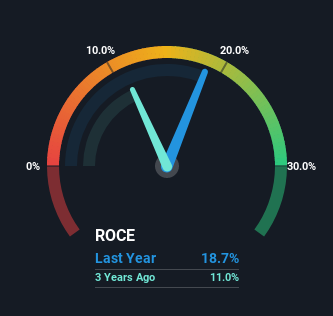- United States
- /
- Auto
- /
- NYSE:THO
There Are Reasons To Feel Uneasy About THOR Industries' (NYSE:THO) Returns On Capital

If we want to find a potential multi-bagger, often there are underlying trends that can provide clues. Amongst other things, we'll want to see two things; firstly, a growing return on capital employed (ROCE) and secondly, an expansion in the company's amount of capital employed. Ultimately, this demonstrates that it's a business that is reinvesting profits at increasing rates of return. In light of that, when we looked at THOR Industries (NYSE:THO) and its ROCE trend, we weren't exactly thrilled.
What Is Return On Capital Employed (ROCE)?
If you haven't worked with ROCE before, it measures the 'return' (pre-tax profit) a company generates from capital employed in its business. To calculate this metric for THOR Industries, this is the formula:
Return on Capital Employed = Earnings Before Interest and Tax (EBIT) ÷ (Total Assets - Current Liabilities)
0.19 = US$1.1b ÷ (US$7.3b - US$1.5b) (Based on the trailing twelve months to January 2023).
So, THOR Industries has an ROCE of 19%. By itself that's a normal return on capital and it's in line with the industry's average returns of 19%.
View our latest analysis for THOR Industries

Above you can see how the current ROCE for THOR Industries compares to its prior returns on capital, but there's only so much you can tell from the past. If you'd like to see what analysts are forecasting going forward, you should check out our free report for THOR Industries.
What The Trend Of ROCE Can Tell Us
In terms of THOR Industries' historical ROCE movements, the trend isn't fantastic. Around five years ago the returns on capital were 35%, but since then they've fallen to 19%. On the other hand, the company has been employing more capital without a corresponding improvement in sales in the last year, which could suggest these investments are longer term plays. It may take some time before the company starts to see any change in earnings from these investments.
On a related note, THOR Industries has decreased its current liabilities to 20% of total assets. That could partly explain why the ROCE has dropped. Effectively this means their suppliers or short-term creditors are funding less of the business, which reduces some elements of risk. Some would claim this reduces the business' efficiency at generating ROCE since it is now funding more of the operations with its own money.
Our Take On THOR Industries' ROCE
Bringing it all together, while we're somewhat encouraged by THOR Industries' reinvestment in its own business, we're aware that returns are shrinking. Additionally, the stock's total return to shareholders over the last five years has been flat, which isn't too surprising. On the whole, we aren't too inspired by the underlying trends and we think there may be better chances of finding a multi-bagger elsewhere.
THOR Industries does have some risks though, and we've spotted 1 warning sign for THOR Industries that you might be interested in.
While THOR Industries may not currently earn the highest returns, we've compiled a list of companies that currently earn more than 25% return on equity. Check out this free list here.
Valuation is complex, but we're here to simplify it.
Discover if THOR Industries might be undervalued or overvalued with our detailed analysis, featuring fair value estimates, potential risks, dividends, insider trades, and its financial condition.
Access Free AnalysisHave feedback on this article? Concerned about the content? Get in touch with us directly. Alternatively, email editorial-team (at) simplywallst.com.
This article by Simply Wall St is general in nature. We provide commentary based on historical data and analyst forecasts only using an unbiased methodology and our articles are not intended to be financial advice. It does not constitute a recommendation to buy or sell any stock, and does not take account of your objectives, or your financial situation. We aim to bring you long-term focused analysis driven by fundamental data. Note that our analysis may not factor in the latest price-sensitive company announcements or qualitative material. Simply Wall St has no position in any stocks mentioned.
About NYSE:THO
THOR Industries
Designs, manufactures, and sells recreational vehicles (RVs), and related parts and accessories in the United States, Germany, Canada, rest of Europe, and internationally.
Flawless balance sheet average dividend payer.


